摘要:
本章介绍了二叉查找树的概念及操作。主要内容包括二叉查找树的性质,如何在二叉查找树中查找最大值、最小值和给定的值,如何找出某一个元素的前驱和后继,如何在二叉查找树中进行插入和删除操作。在二叉查找树上执行这些基本操作的时间与树的高度成正比,一棵随机构造的二叉查找树的期望高度为O(lgn),从而基本动态集合的操作平均时间为θ(lgn)。
1、二叉查找树
二叉查找树是按照二叉树结构来组织的,因此可以用二叉链表结构表示。二叉查找树中的关键字的存储方式满足的特征是:设x为二叉查找树中的一个结点。如果y是x的左子树中的一个结点,则key[y]≤key[x]。如果y是x的右子树中的一个结点,则key[x]≤key[y]。根据二叉查找树的特征可知,采用中根遍历一棵二叉查找树,可以得到树中关键字有小到大的序列。http://www.cnblogs.com/Anker/archive/2013/01/27/2878594.html介绍了二叉树概念及其遍历。一棵二叉树查找及其中根遍历结果如下图所示:

书中给出了一个定理:如果x是一棵包含n个结点的子树的根,则其中根遍历运行时间为θ(n)。
问题:二叉查找树性质与最小堆之间有什么区别?能否利用最小堆的性质在O(n)时间内,按序输出含有n个结点的树中的所有关键字?
2、查询二叉查找树
二叉查找树中最常见的操作是查找树中的某个关键字,除了基本的查询,还支持最大值、最小值、前驱和后继查询操作,书中就每种查询进行了详细的讲解。
(1)查找SEARCH
在二叉查找树中查找一个给定的关键字k的过程与二分查找很类似,根据二叉查找树在的关键字存放的特征,很容易得出查找过程:首先是关键字k与树根的关键字进行比较,如果k大比根的关键字大,则在根的右子树中查找,否则在根的左子树中查找,重复此过程,直到找到与遇到空结点为止。例如下图所示的查找关键字13的过程:(查找过程每次在左右子树中做出选择,减少一半的工作量)

书中给出了查找过程的递归和非递归形式的伪代码:
1 TREE_SEARCH(x,k)
2 if x=NULL or k=key[x]
3 then return x
4 if(k<key[x])
5 then return TREE_SEARCH(left[x],k)
6 else
7 then return TREE_SEARCH(right[x],k)
1 ITERATIVE_TREE_SEARCH(x,k)
2 while x!=NULL and k!=key[x]
3 do if k<key[x]
4 then x=left[x]
5 else
6 then x=right[x]
7 return x
(2)查找最大关键字和最小关键字
根据二叉查找树的特征,很容易查找出最大和最小关键字。查找二叉树中的最小关键字:从根结点开始,沿着各个节点的left指针查找下去,直到遇到NULL时结束。如果一个结点x无左子树,则以x为根的子树中,最小关键字就是key[x]。查找二叉树中的最大关键字:从根结点开始,沿着各个结点的right指针查找下去,直到遇到NULL时结束。书中给出了查找最大最小关键字的伪代码:
1 TREE_MINMUM(x)
2 while left[x] != NULL
3 do x=left[x]
4 return x
1 1 TREE_MAXMUM(x)
2 2 while right[x] != NULL
3 3 do x= right[x]
4 4 return x
(3)前驱和后继
给定一个二叉查找树中的结点,找出在中序遍历顺序下某个节点的前驱和后继。如果树中所有关键字都不相同,则某一结点x的前驱就是小于key[x]的所有关键字中最大的那个结点,后继即是大于key[x]中的所有关键字中最小的那个结点。根据二叉查找树的结构和性质,不用对关键字做任何比较,就可以找到某个结点的前驱和后继。
查找前驱步骤:先判断x是否有左子树,如果有则在left[x]中查找关键字最大的结点,即是x的前驱。如果没有左子树,则从x继续向上执行此操作,直到遇到某个结点是其父节点的右孩子结点。例如下图查找结点7的前驱结点6过程:
查找后继步骤:先判断x是否有右子树,如果有则在right[x]中查找关键字最小的结点,即使x的后继。如果没有右子树,则从x的父节点开始向上查找,直到遇到某个结点是其父结点的左儿子的结点时为止。例如下图查找结点13的后继结点15的过程:
书中给出了求x结点后继结点的伪代码:
1 TREE_PROCESSOR(x)
2 if right[x] != NULL
3 then return TREE_MINMUM(right(x))
4 y=parent[x]
5 while y!= NULL and x ==right[y]
6 do x = y
7 y=parent[y]
8 return y
定理:对一棵高度为h的二叉查找,动态集合操作SEARCH、MINMUM、MAXMUM、SUCCESSOR、PROCESSOR等的运行时间均为O(h)。
3、插入和删除
插入和删除会引起二叉查找表示的动态集合的变化,难点在在插入和删除的过程中要保持二叉查找树的性质。插入过程相当来说要简单一些,删除结点比较复杂。
(1)插入
插入结点的位置对应着查找过程中查找不成功时候的结点位置,因此需要从根结点开始查找带插入结点位置,找到位置后插入即可。下图所示插入结点过程:
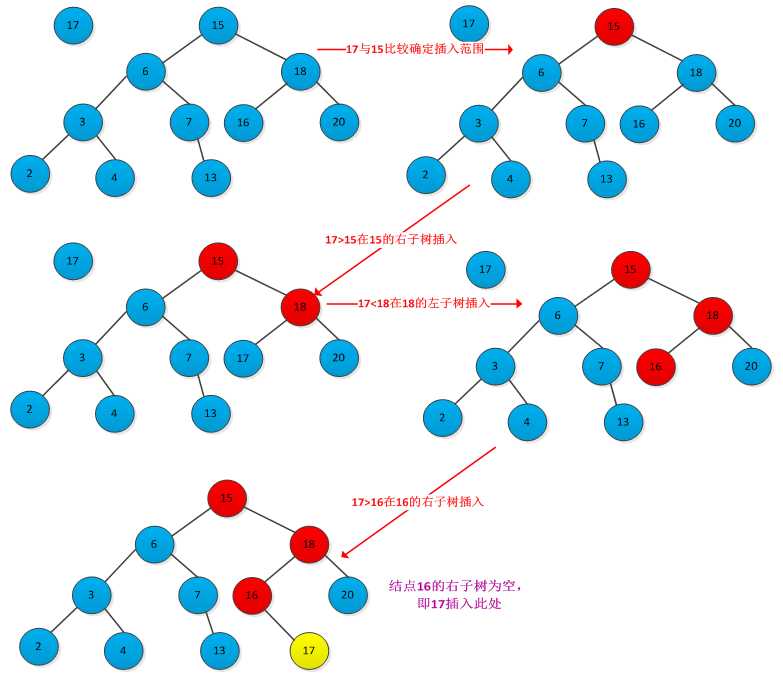
书中给出了插入过程的伪代码:
1 TREE_INSERT(T,z)
2 y = NULL;
3 x =root[T]
4 while x != NULL
5 do y =x
6 if key[z] < key[x]
7 then x=left[x]
8 else x=right[x]
9 parent[z] =y
10 if y=NULL
11 then root[T] =z
12 else if key[z]>key[y]
13 then keft[y] = z
14 else right[y] =z
插入过程运行时间为O(h),h为树的高度。
(2)删除
从二叉查找树中删除给定的结点z,分三种情况讨论:
<1>结点z没有左右子树,则修改其父节点p[z],使其为NULL。删除过程如下图所示:
<2>如果结点z只有一个子树(左子树或者右子树),通过在其子结点与父节点建立一条链来删除z。删除过程如下图所示:
<3>如果z有两个子女,则先删除z的后继y(y没有左孩子),在用y的内容来替代z的内容。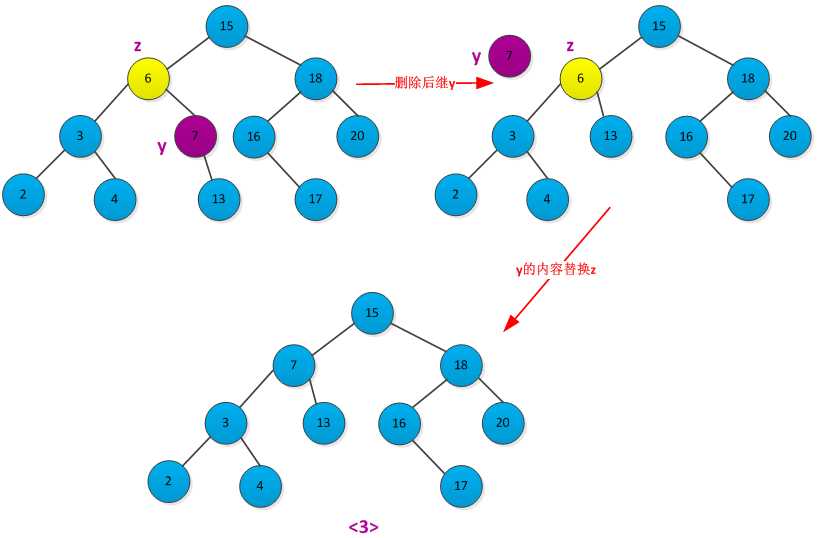
书中给出了删除过程的伪代码:
1 TREE_DELETE(T,z)
2 if left[z] ==NULL or right[z] == NULL
3 then y=z
4 else y=TREE_SUCCESSOR(z)
5 if left[y] != NULL
6 then x=left[y]
7 else x=right[y]
8 if x!= NULL
9 then parent[x] = parent[y]
10 if p[y] ==NULL
11 then root[T] =x
12 else if y = left[[prarnt[y]]
13 then left[parent[y]] = x
14 else right[parent[y]] =x
15 if y!=z
16 then key[z] = key[y]
17 copy y‘s data into z
18 return y
定理:对高度为h的二叉查找树,动态集合操作INSERT和DELETE的运行时间为O(h)。
4、实现测试
采用C++语言实现一个简单的二叉查找树,支持动态集合的基本操作:search、minmum、maxmum、predecessor、successor、insert和delete。设计的二叉查找树结构如下所示:
1 template <class T>
2 class BinarySearchTreeNode
3 {
4 public:
5 T elem;
6 struct BinarySearchTreeNode<T> *parent;
7 struct BinarySearchTreeNode<T>* left;
8 struct BinarySearchTreeNode<T>* right;
9 };
10
11 template <class T>
12 class BinarySearchTree
13 {
14 public:
15 BinarySearchTree();
16 void tree_insert(const T& elem);
17 int tree_remove(const T& elem );
18 BinarySearchTreeNode<T>* tree_search(const T& elem)const;
19 T tree_minmum(BinarySearchTreeNode<T>* root)const;
20 T tree_maxmum(BinarySearchTreeNode<T>* root)const;
21 T tree_successor(const T& elem) const;
22 T tree_predecessor(const T& elem)const;
23 int empty() const;
24 void inorder_tree_walk()const;
25 BinarySearchTreeNode<T>* get_root()const {return root;}
26 private:
27 BinarySearchTreeNode<T>* root;
28 };
完整程序如下所示:
1 #include <iostream>
2 #include <stack>
3 #include <cstdlib>
4 using namespace std;
5
6 template <class T>
7 class BinarySearchTreeNode
8 {
9 public:
10 T elem;
11 struct BinarySearchTreeNode<T> *parent;
12 struct BinarySearchTreeNode<T>* left;
13 struct BinarySearchTreeNode<T>* right;
14 };
15
16 template <class T>
17 class BinarySearchTree
18 {
19 public:
20 BinarySearchTree();
21 void tree_insert(const T& elem);
22 int tree_remove(const T& elem );
23 BinarySearchTreeNode<T>* tree_search(const T& elem)const;
24 T tree_minmum(BinarySearchTreeNode<T>* root)const;
25 T tree_maxmum(BinarySearchTreeNode<T>* root)const;
26 T tree_successor(const T& elem) const;
27 T tree_predecessor(const T& elem)const;
28 int empty() const;
29 void inorder_tree_walk()const;
30 BinarySearchTreeNode<T>* get_root()const {return root;}
31 private:
32 BinarySearchTreeNode<T>* root;
33 };
34
35 template <class T>
36 BinarySearchTree<T>::BinarySearchTree()
37 {
38 root = NULL;
39 }
40
41 template <class T>
42 void BinarySearchTree<T>::tree_insert(const T& elem)
43 {
44 if(!empty())
45 {
46 BinarySearchTreeNode<T> *pnode = root;
47 BinarySearchTreeNode<T> *qnode = NULL;
48 BinarySearchTreeNode<T> *newnode = new BinarySearchTreeNode<T>;
49 newnode->elem = elem;
50 newnode->parent = NULL;
51 newnode->left = NULL;
52 newnode->right = NULL;
53 while(pnode)
54 {
55 qnode = pnode;
56 if(pnode->elem > elem)
57 pnode = pnode->left;
58 else
59 pnode = pnode->right;
60 }
61 if(qnode->elem > elem)
62 qnode->left = newnode;
63 else
64 qnode->right = newnode;
65 newnode->parent = qnode;
66 }
67 else
68 {
69 root = new BinarySearchTreeNode<T>;
70 root->elem = elem;
71 root->parent =NULL;
72 root->left = NULL;
73 root->right = NULL;
74 }
75 }
76
77 template <class T>
78 int BinarySearchTree<T>::tree_remove(const T&elem)
79 {
80 BinarySearchTreeNode<T> *pnode;
81 BinarySearchTreeNode<T> *parentnode,*snode;
82 pnode = tree_search(elem);
83 if(pnode != NULL)
84 {
85 parentnode = pnode->parent;
86 if(pnode->right == NULL || pnode->left == NULL)
87 {
88 if(pnode->right != NULL)
89 {
90 if(parentnode->left == pnode)
91 parentnode->left = pnode->right;
92 if(parentnode->right == pnode)
93 parentnode->right = pnode->right;
94 pnode->right->parent = parentnode;
95 }
96 else if(pnode->left != NULL)
97 {
98 if(parentnode->left == pnode)
99 parentnode->left = pnode->left;
100 if(parentnode->right == pnode)
101 parentnode->right = pnode->left;
102 pnode->left->parent = parentnode;
103 }
104 else
105 {
106 if(parentnode->left == pnode)
107 parentnode->left = NULL;
108 if(parentnode->right == pnode)
109 parentnode->right = NULL;
110 }
111 delete pnode;
112 }
113 else
114 {
115 snode = tree_search(tree_successor(pnode->elem));
116 pnode->elem = snode->elem;
117 if(snode->parent->left == snode)
118 {
119 snode->parent->left = snode->right;
120 snode->right->parent = snode->parent->left;
121 }
122 if(snode->parent->right == snode)
123 {
124 snode->parent->right = snode->right;
125 snode->right->parent = snode->parent->right;
126 }
127 delete snode;
128 }
129 return 0;
130 }
131 return -1;
132 }
133 template <class T>
134 BinarySearchTreeNode<T>* BinarySearchTree<T>::tree_search(const T& elem)const
135 {
136 BinarySearchTreeNode<T> *pnode = root;
137 while(pnode)
138 {
139 if(pnode->elem == elem)
140 break;
141 else if(pnode->elem > elem)
142 pnode = pnode->left;
143 else
144 pnode = pnode->right;
145 }
146 return pnode;
147 }
148
149 template <class T>
150 T BinarySearchTree<T>::tree_minmum(BinarySearchTreeNode<T>* root)const
151 {
152 BinarySearchTreeNode<T> *pnode = root;
153 if(pnode->left)
154 {
155 while(pnode->left)
156 pnode = pnode->left;
157 }
158 return pnode->elem;
159 }
160
161 template <class T>
162 T BinarySearchTree<T>::tree_maxmum(BinarySearchTreeNode<T>* root)const
163 {
164 BinarySearchTreeNode<T> *pnode = root;
165 if(pnode->right)
166 {
167 while(pnode->right)
168 pnode = pnode->right;
169 }
170 return pnode->elem;
171 }
172
173 template <class T>
174 T BinarySearchTree<T>::tree_successor(const T& elem) const
175 {
176 BinarySearchTreeNode<T>* pnode = tree_search(elem);
177 BinarySearchTreeNode<T>* parentnode;
178 if(pnode != NULL)
179 {
180 if(pnode->right)
181 return tree_minmum(pnode->right);
182 parentnode = pnode->parent;
183 while(parentnode && pnode == parentnode->right)
184 {
185 pnode = parentnode;
186 parentnode = parentnode->parent;
187 }
188 if(parentnode)
189 return parentnode->elem;
190 else
191 return T();
192 }
193 return T();
194 }
195 template <class T>
196 T BinarySearchTree<T>::tree_predecessor(const T& elem)const
197 {
198 BinarySearchTreeNode<T>* pnode = tree_search(elem);
199 BinarySearchTreeNode<T>* parentnode;
200 if(pnode != NULL)
201 {
202 if(pnode->right)
203 return tree_maxmum(pnode->right);
204 parentnode = pnode->parent;
205 while(parentnode && pnode == parentnode->left)
206 {
207 pnode = parentnode;
208 parentnode = pnode->parent;
209 }
210 if(parentnode)
211 return parentnode->elem;
212 else
213 return T();
214 }
215 return T();
216 }
217
218 template <class T>
219 int BinarySearchTree<T>::empty() const
220 {
221 return (NULL == root);
222 }
223
224 template <class T>
225 void BinarySearchTree<T>::inorder_tree_walk()const
226 {
227 if(NULL != root)
228 {
229 stack<BinarySearchTreeNode<T>*> s;
230 BinarySearchTreeNode<T> *ptmpnode;
231 ptmpnode = root;
232 while(NULL != ptmpnode || !s.empty())
233 {
234 if(NULL != ptmpnode)
235 {
236 s.push(ptmpnode);
237 ptmpnode = ptmpnode->left;
238 }
239 else
240 {
241 ptmpnode = s.top();
242 s.pop();
243 cout<<ptmpnode->elem<<" ";
244 ptmpnode = ptmpnode->right;
245 }
246 }
247 }
248 }
249 int main()
250 {
251 BinarySearchTree<int> bstree;
252 BinarySearchTreeNode<int>* ptnode,*proot;
253 bstree.tree_insert(32);
254 bstree.tree_insert(21);
255 bstree.tree_insert(46);
256 bstree.tree_insert(54);
257 bstree.tree_insert(16);
258 bstree.tree_insert(38);
259 bstree.tree_insert(70);
260 cout<<"inorder tree walk is: ";
261 bstree.inorder_tree_walk();
262 proot = bstree.get_root();
263 cout<<"\nmax value is: "<<bstree.tree_maxmum(proot)<<endl;
264 cout<<"min value is: "<<bstree.tree_minmum(proot)<<endl;
265 ptnode = bstree.tree_search(38);
266 if(ptnode)
267 cout<<"the element 38 is exist in the binary tree.\n";
268 else
269 cout<<"the element 38 is not exist in the binary tree.\n";
270 cout<<"the successor of 38 is: "<<bstree.tree_successor(38)<<endl;
271 cout<<"the predecessor of 38 is:"<<bstree.tree_predecessor(38)<<endl;
272 if(bstree.tree_remove(46) == 0)
273 cout<<"delete 46 successfully"<<endl;
274 else
275 cout<<"delete 46 failed"<<endl;
276 cout<<"inorder tree walk is: ";
277 bstree.inorder_tree_walk();
278 exit(0);
279 }
程序测试结果如下所示:

二叉树实现时候添加了一个父结点指针,方便寻找给定结点的前驱和后继。二叉树中删除操作实现比较复杂,需要分类讨论,我分三种情况进行讨论,程序写的有些繁琐,可以进行优化。优化后的代码如下:
1 template <class T>
2 int BinarySearchTree<T>::tree_delete(const T& elem)
3 {
4 //找到该元素对应的结点
5 BinarySearchTreeNode<T>* pnode = tree_search(elem);
6 if(NULL != pnode)
7 {
8 BinarySearchTreeNode<T> *qnode,*tnode;
9 //判断结点是否有左右孩子
10 if(pnode->left == NULL || pnode->right == NULL)
11 qnode = pnode; //有一个左孩子或者一个右孩子和没有左右孩子
12 else
13 qnode = tree_search(tree_successor(elem)); //有左右孩子
14 if(NULL != qnode->left)
15 tnode = qnode->left;
16 else
17 tnode = qnode->right;
18 if(NULL != tnode)
19 tnode->parent = qnode->parent;
20 if(qnode->parent == NULL)
21 root = tnode;
22 else
23 if(qnode == qnode->parent->left)
24 qnode->parent->left = tnode;
25 else
26 qnode->parent->right = tnode;
27 if(qnode != pnode)
28 pnode->elem = qnode->elem; //将后继结点的值复制到要删除的结点的值
29 delete qnode;
30 return 0;
31 }
32 return -1;
33 }
5、随机构造二叉查找树
二叉查找上各种基本操作的运行时间都是O(h),h为树的高度。但是在元素插入和删除过程中,树的高度会发生改变。如果n个元素按照严格增长的顺序插入,那个构造出的二叉查找树的高度为n-1。例如按照先后顺序插入7、15、18、20、34、46、59元素构造二叉查找树,二叉查找树结构如下所示: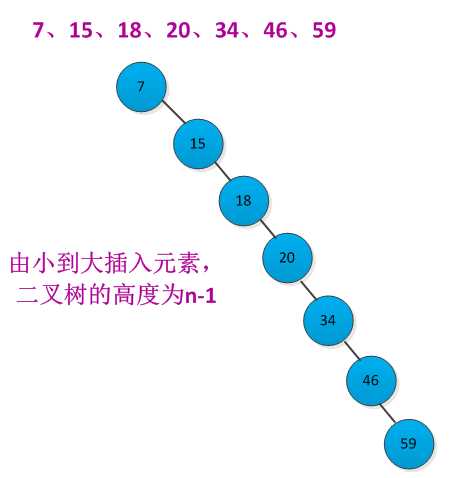
《算法导论》读书笔记之第13章 红黑树
摘要:
红黑树是一种二叉查找树,但在每个结点上增加了一个存储位表示结点的颜色,可以是RED或者BLACK。通过对任何一条从根到叶子的路径上各个着色方式的限制,红黑树确保没有一条路径会比其他路径长出两倍,因而是接近平衡的。本章主要介绍了红黑树的性质、左右旋转、插入和删除。重点分析了在红黑树中插入和删除元素的过程,分情况进行详细讨论。一棵高度为h的二叉查找树可以实现任何一种基本的动态集合操作,如SEARCH、PREDECESSOR、SUCCESSOR、MIMMUM、MAXMUM、INSERT、DELETE等。当二叉查找树的高度较低时,这些操作执行的比较快,但是当树的高度较高时,这些操作的性能可能不比用链表好。红黑树(red-black tree)是一种平衡的二叉查找树,它能保证在最坏情况下,基本的动态操作集合运行时间为O(lgn)。本章内容有些复杂,看了两天,才大概清楚其插入和删除过程,日后需要经常回顾,争取完全消化掉。红黑树的用途非常广泛,例如STL中的map就是采用红黑树实现的,效率非常之高,有机会可以研究一下STL的源代码。
1、红黑树的性质
红黑树中的每个结点包含五个域:color、key、left、right和parent。如果某结点没有一个子结点或父结点,则该结点相应的指针parent域包含值为NIL(NIL并是是空指针,此处有些迷惑,一会解释)。把NIL视为指向红黑树的外结点(叶子)的指针,而把带关键字的结点视为红黑树的内结点。红黑树结点结构如下所示:
1 #define RED 0
2 #define BLACK 1
3 struct RedBlackTreeNode
4 {
5 T key;
6 struct RedBlackTreeNode * parent;
7 struct RedBlackTreeNode * left;
8 struct RedBlackTreeNode * right;
9 int color;
10 };
红黑树的性质如下:
(1)每个结点或是红色,或是黑色。
(2)根结点是黑色。
(3)每个叶子结点(NIL)是黑色。
(4)如果有一个结点是红色,则它的两个儿子都是黑色。
(5)对每个结点,从该结点到其孙子结点的所有路径上包含相同数目的黑色结点。
如下图是一棵红黑树:
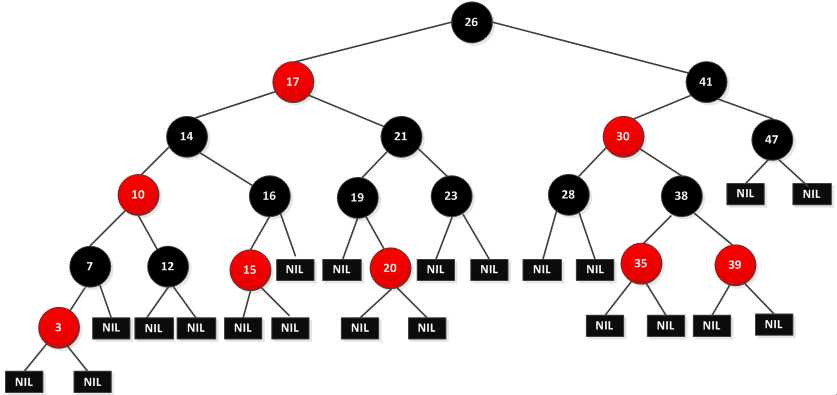
从图可以看出NIL不是空指针,而是一个叶子结点。实际操作的时候可以将NIL视为哨兵,这样便于对黑红色进行操作。红黑树的操作主要是对内部结点操作,因为内部结点存储了关键字的值。书中为了便于讨论,忽略了叶子结点的,如是上图红黑树变成如下图所示: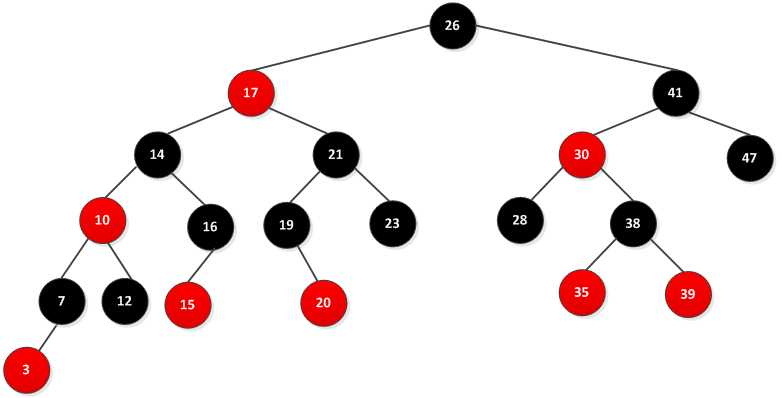
书中给出了黑高度的概念:从某个结点x出发(不包含该结点)到达一个叶子结点的任意一条路径上,黑色结点的个数称为该结点的黑高度。由红黑树的性质(5)可知,从该结点出发的所有下降路径都有相同的黑色结点个数。红黑树的黑高度定义为其根结点的黑高度。
书中给出了一个引理来说明为什么红黑树是一种好的查找树,并对引理进行了证明(采用归纳法进行证明的,需要很强的归纳推理知识,正是我的不足之处,看书的痛苦在于此)。
引理:一棵有n个内结点的红黑树的高度之多为2lg(n+1)。
2、旋转
在红黑树上进行结点插入和删除操作时,会改变树的结构形状,导致结果可能不满足了红黑树的某些性质,为了保证每次插入和删除操作后,仍然能报维持红黑树的性质,需要改变树中某些结点的颜色和指针结构。其中的指针结构的改变通过旋转完成的。书中给出了两种旋转:左旋转和右旋转。如下图是旋转过程:
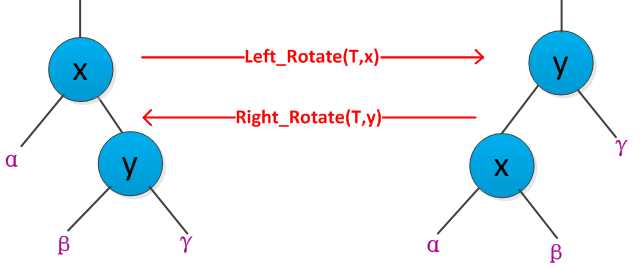
从图可以得出左右旋转的过程,假设对某个结点x进行左旋转,y是x的右孩子,则左旋转过程为:以x和y之间的链为“支轴”进行的,使得x的右孩子为y的左孩子,y的父节点为x的父节点,y的左孩子为x。书中给出了左旋转的伪代码如下:
1 LEFT_ROTATE(T,x)
2 y = right[x] //获取右孩子
3 rihgt[x] = left[y] //设置x的右孩子为y的左孩子
4 if left[y] != NIL
5 then parent[left[x]] = x
6 parent[y] = parent[x] //设置y的父节点为x的父节点
7 if parent[x] == NIL
8 then root[T] = y
9 else if x==left[parent[x]
10 then left[parent[x]] = y
11 else right[[parent[x]] = y
12 left[y] = x //设置y的左孩子为x
13 parent[x] =y
14
15
假设对某个结点y进行右旋转,x是y的左孩子,则左旋转过程为:y的左孩子设置为x的右孩子,将x的父节点设置为y的父节点,x的右孩子设置为y。书中并没有给出右旋转的伪代码,参照左旋转的伪代码很容易实现:
1 RIGHT_ROTATE(T,y)
2 x = left[y] //获取左孩子
3 left[y] = right[x] //设置y的左孩子为x的右孩子
4 if right[x] != NIL
5 then parent[right[x]] = y
6 parent[x] = parent[y] //设为x的父节点为y的父结点
7 if parent[y] == NIL
8 then root = x
9 else if y== left[parent[y]]
10 then left[parent[y]] = x
11 else right[parent[y]] = x
12 right[x] = y //设置x的右孩子为y
13 parent[y] = x
为了更好的理解旋转操作,书中给出了一个左旋转的例如,如下图所示:
3、插入
红黑树插入一个新结点的过程RB_INSERT是在二叉查找树插入过程的基础上改进的,先按照二叉排序的插入过程插入到红黑树中,然后将新插入的结点标记为红色(疑问:为什么是红色,而不是黑色呢?),然后调用一个辅助的过程RB_INSERT_FIXUP来调整结点并重新着色,使得满足红黑树的性质。关于二叉查找树的插入过程可以参考上一篇日志:http://www.cnblogs.com/Anker/archive/2013/01/28/2880581.html。书中给出了RB_INSERT的伪代码:
1 RB_INSERT(T,z)
2 y = NIL
3 x =root(T)
4 while x != NIL
5 do y=x
6 if key[z]<key[x]
7 then x=left[x]
8 else x=right[x]
9 parent[z] = y
10 if y =NIL
11 then root =z
12 else if key[z] < key[y]
13 then left[y] =z
14 else right[y] =z
15 left[z] = NIL
16 right[z] =NIL
17 color[z] = RED //新插入结点标记为红色
18 RB_INSERT_FIXUP(T,z) //进行调整,使得满足红黑树性质
红黑树的插入过程最主要的是RB_INSERT_FIXUP过程,书中发了很大的篇幅进行介绍。首先分析了当插入一个新的结点后,会破坏红黑树的哪些性质,然后针对可能的破坏性质进行分类讨论并给出了给出了解决办法。因为每次插入的新元素标记为RED,这样可能性质2(根节点为黑色)和性质4(一个红结点的左右孩子都是黑色的)被破坏。例如下图插入一个新结点,破坏了性质4。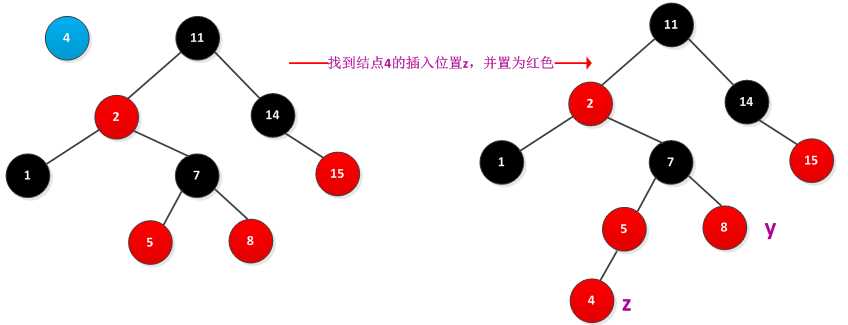
如果每次插入新的结点z导致红黑树性质被破坏,则之多只有一个性质被破坏,并且不是性质2就是性质4。违反性质2是因为z是根且为红色,违反性质4是因为z和其父节点parent[z]都是红色的。
如果性质2被违反了,则红色的根必定是新增的结点z,它是树中唯一的内结点,由于z的父接点和两个子女都是NIL(黑色),不违反性质4。违反性质2在整个插入过程中只有这一次。所以对于违反性质2的结点,直接将其结点变成黑色即可。
剩下的问题是对于违反性质4的处理,在插入新结点z之前,红黑树的性质没有被破坏。插入结点z后违反性质4,必定是因为z和其父亲结点parent[z]都是红色的,此时只违反性质4,而没有违反其他性质。假设新插入结点z,导致红黑树性质4被破坏,此时z和其父节点parent[z]都是红色,由于在插入结点z之前红黑树的性质没有被破坏,parent[z]是红色,很容易推出z的祖父结点parent[parent[z]]必定是黑色。此时根据parent[z]是parent[parent[z]]的左孩子还是右孩子进行讨论。因为左右之间是对称的,书中只给出了parent[z]作为parent[parent[z]]的左孩子进行讨论的,然后给出了三种可能的情况。
情况1):z的叔叔结点y是红色的
此时parent[z]和y都是红色的,解决办法是将z的父节点parent[z]和叔叔结点y都着为黑色,而将z的祖父结点parent[parent[z]]着为红色,然后从祖父结点parent[parent[z]]继续向上判断是否破坏红黑树的性质。处理过程如下图所示:
情况2):z的叔叔y是黑色的,而且z是右孩子
情况3):z的叔叔y是黑色的,而且z是左孩子
情况2和情况3中y都是黑色的,通过z是左孩子还是右孩子进行区分的。可以将情况2通过旋转为情况3。情况2中z是右孩子,旋转后成为情况3,使得z变为左孩子,可以在parent[z]结点出使用一次左旋转来完成。无论是间接还是直接的通过情况2进入到情况3,z的叔叔y总是黑色的。在情况3中,将parent[z]着为黑色,parent[parent[z]]着为红色,然后从parent[parent[z]]处进行一次右旋转。情况2、3修正了对性质4的违反,修正过程不会导致其他的红黑性质被破坏。修正过程如下图所示:
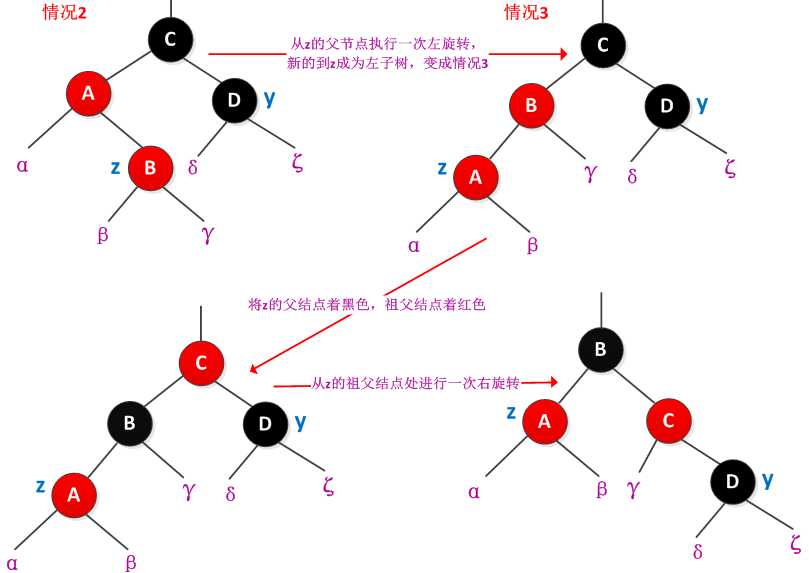
给一个完整的例子来说明插入过程,如下图所示: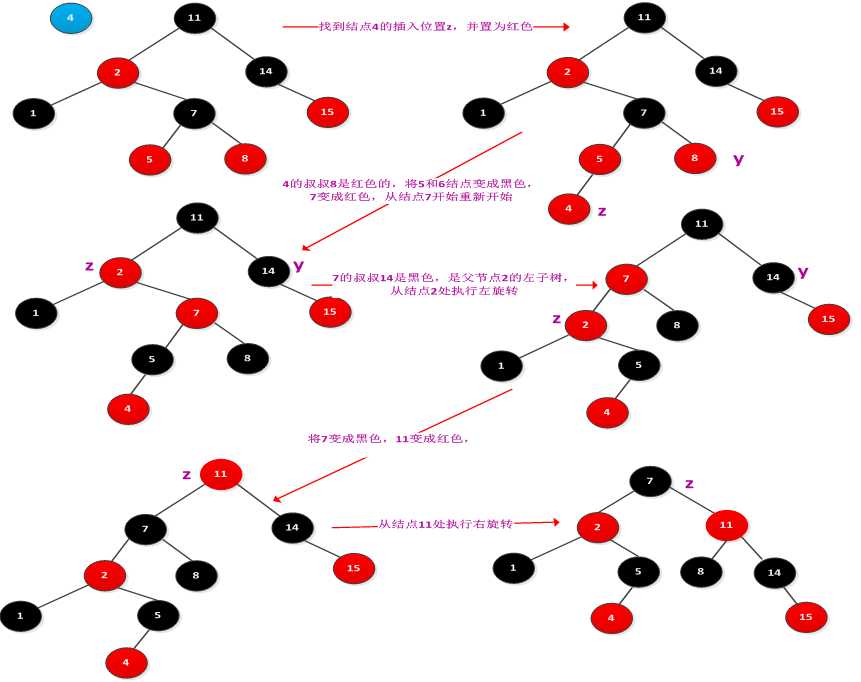
书中给出了RB_INSERT_FIXUP的伪代码,伪代码中只给出了z的父节点为左孩子的情况,为右孩子的情况与左孩子的情况是对称的,只需将左孩子中的right换成left即可。
1 RB_INSERT_FIXUP(T,z)
2 while color[parent[z]] = RED
3 do if parent[z] == left[parent[parent[z]]]
4 then y = right[parent[parent[z]]]
5 if color[y] == RED //情况1,z的叔叔为红色
6 then color[parent[z]] = BLACK
7 color[y] = BLACK
8 color[parent[parent[z]]=RED
9 z= parent[parent[z]]
10 else if z == right[parent[z]] //情况2,z的叔叔为黑色,z为右孩子
11 then z = parent[z]
12 LEFT_ROTATE(T,z)
13 color[parent[z]]=BLACK //情况3,z的叔叔为黑色,z为左孩子
14 color[parent[parent[z]] = RED
15 RIGHT_ROTATE(T, parent[parent[z]])
16 else (same as then clause with “right” and “left” exchanged)
17 color(root(T)) = BLACK; //将根结点设置为黑色
4、删除
删除过程最复杂,看了好多遍才明白个大概,需要反复看,多想删除过程中会破坏哪些性质,然后又针对性的去调整。
红黑树删除结点过程是在二叉查找树删除结点过程的基础改进的。与二叉查找树类似,删除的结点分为三种情况:<1>无左右孩子、<2>有左孩子或者右孩子、<3>既有树=左孩子又有右孩子。删除过程可以参考前一篇日志:http://www.cnblogs.com/Anker/archive/2013/01/28/2880581.html。红黑树在删除结点后需要检查是否破坏了红黑树的性质。如果删除的结点y是红色的,则删除后的树仍然是保持红黑树的性质,因为树中各个结点的黑高度没有改变,不存在两个相邻(父结点和子结点)的红色结点,y是红色不可能是根,所有根仍然是黑色。如果删除的结点z是黑色的,则这个是破坏了红黑树的性质,需要调用RB_DELETE_FIXUP进行调整。从删除结点y的唯一孩子结点x或者是NIL处开始调整。书中给出了RB_DELETE的伪代码:
1 RB_DELETE(T,z)
2 if left[z] ==NIL or right[z] == NIL
3 then y=z
4 else y=TREE_SUCCESSOR(z)
5 if left[y] != NIL
6 then x=left[y]
7 else x=right[y]
8 parent[x] = parent[y]
9 if p[y] ==NIL
10 then root[T] =x
11 else if y = left[[prarnt[y]]
12 then left[parent[y]] = x
13 else right[parent[y]] =x
14 if y!=z
15 then key[z] = key[y]
16 copy y‘s data into z
17 if color[y] == BLACK //当被删除结点为黑色时候进行调整
18 then RB_DELETE_FIXUP(T,x)
19 return y
书中分析了被删除结点y是黑色会产生的问题:首先,如果y是根,而y的一个红色孩子变成了新根,则违反了性质2。其次,如果x和parent[y](此时parent[x] = parent[y])都是红色,就违反了性质4。第三,删除y将会导致先前包含y的任何路径上黑结点个数减少1,违反了性质5。书中给出了解决第三个问题的办法:将结点x设为还有额外的一重黑色(此处看的不是很明白,我的理解是是不管是x是什么颜色,将x增加了额外一重黑色,这样可以保证黑结点数目增加1个),即将任意包含结点x的路径上黑结点个数加1,这样可以保证性质5成立。当将黑色结点y被删除时,将其黑色“下推”至其子结点,导致问题变成为结点x可能即不是红,又不是黑,从而违反性质1。因为给x增加了一种颜色,即结点x是双重黑色或者是红黑色。这样就分别给包含x的路径上黑结点个数贡献2个或1个。但是x的color属性仍然是RED(如果x是红黑的)或BLACK(如果x是双重黑色)。换而言之,一个结点额外的黑色反映在x指向它,而不是它的color属性。
过程RB_DELETE_FIXUP恢复性质1,2,4。对于恢复性质2、4很简单,因为x是红色,所有直接将x结点着为黑色即可。书中着重介绍了如何恢复性质1。此时x是黑色,需要根据x是左孩子还是右孩子两种情况进行恢复,因为左右是对称的,书中只给出了x是左孩子的恢复过程。将x作为第一个额外的黑色结点,从x结点开始循环,将额外的黑色结点沿着树向上移,直到:
(1)x指向一个红黑结点,此时将x单独着为黑色。
(2)x指向根,这时可以简单地消除那个额外的黑色,或者
(3)做必要的旋转和颜色改变
在循环过程中,x总是指向具有双重黑色的那个非根结点。设w是x的兄弟结点,因为x是双重黑色的,故w不可能是NIL。书中分四种情况讨论:
情况1:x的兄弟w是红色的
此时因为x是双重黑色,贡献两个黑色结点,所有w必有黑色孩子。此时将w着为黑色,parent[x]为红色,在对parent[x]做一次左旋转。此时x的新兄弟w是黑色,这样将情况1转换为情况2、3或4。情况1的处理过程下图所示:
情况2:x的兄弟w是黑色的,而且w的两个孩子都是黑色的。
处理过程是从x和w上去掉一重黑色,即x只有一重黑色而w着为红色,给x的父节点parent[x]添加额外黑色。处理过程如下图所示: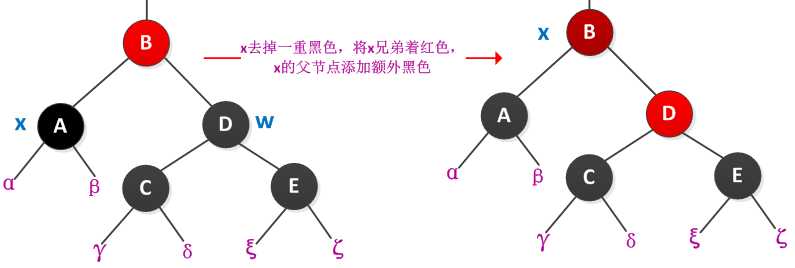
情况3:x的兄弟w是黑色的,w的左孩子是红色的,右孩子是黑色的
交换w和其左孩子left[w]的颜色,并对w进行右旋转。旋转后x的新兄弟w是一个有红色右孩子的黑结点,转换成了情况4。处理过程如下图所示: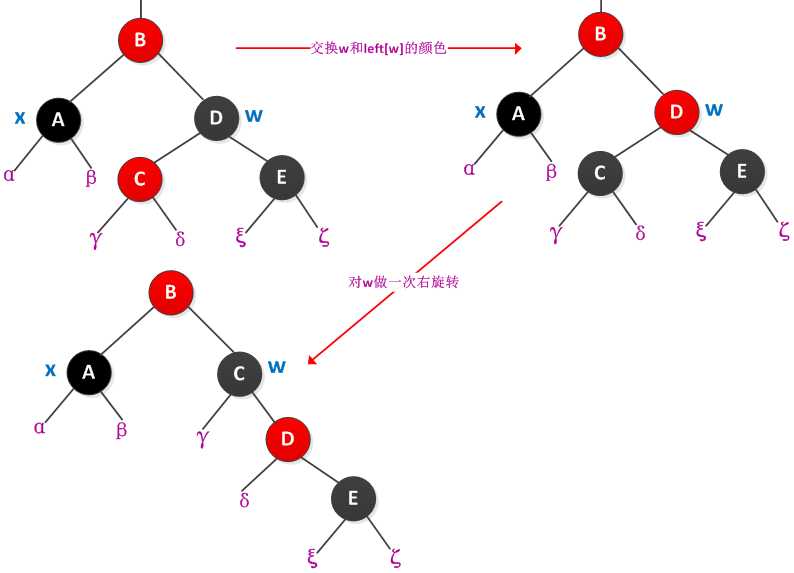
情况4:x的兄弟w是黑色的,而且w的右孩子是红色的。
执行过程是将w的颜色设置为parent[x]的颜色,将parent[x]的颜色设置为黑色,将w的右孩子着为黑色,然后在parent[x]做一次右旋,最后将x设置为根root。处理过程如下图所示:
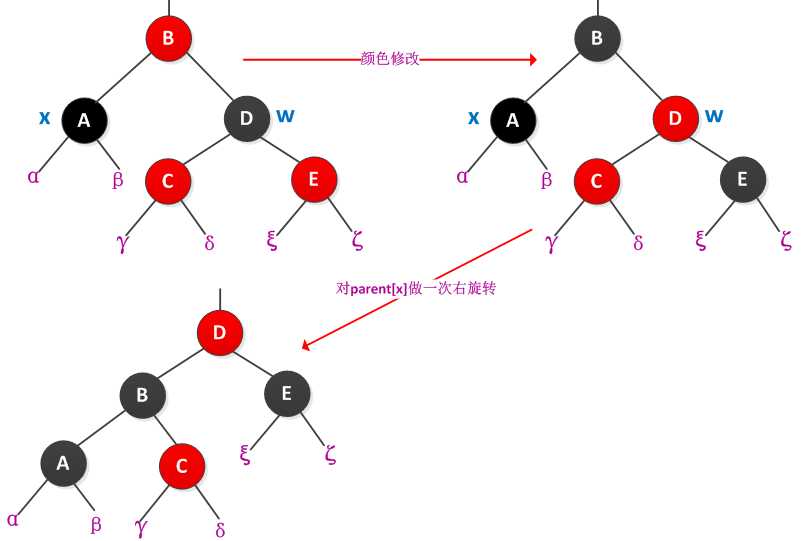
书中给出了RB_DELETE_FIXUP的伪代码:
1 RB_DELETE_FIXUP(T,x)
2 while x!= root[T] and color[x] ==BLACK
3 do if x == left[parent[x]]
4 then w = right[parent[x]]
5 if color[w] == RED //case 1 x的兄弟w是红色的
6 then color[w] = BLACK
7 color[parent[x]] = RED
8 LEFT_ROTATE(T,PARENT[x])
9 w = right[parent[x]]
10 if color[left[w]] == BLACK and color[right[w]] = BLACK
11 then color[w] = RED //case 2
12 x = parent[x]
13 else if color[right[w]] =BLACK
14 then color[left[w]] = BLACK //case 3
15 color[w] = RED
16 RIGHT_ROTATE(T,w)
17 w = right[parent[x]]
18 color[w] = color[parent[x]] //case 4
19 color[parent[x]] = BLACK
20 color[right[w]] = BLACK
21 LEFT_ROTATE(T,parent[x])
22 x=root(T)
23 else(same as then clasue with “right” and “left” exchanged)
24 color[x]=BLACK
5、编程实现
这一章看了两天,宏观上把握了红黑树的插入和删除操作,中间还有细节问题需要思考。看完后要实现才能消化,于是我采用C++语言设计了简单的红黑树结点和红黑树类,设计的类如下所示:
1 static const int RED = 0;
2 static const int BLACK = 1;
3
4 template <class T>
5 class RedBlackTreeNode
6 {
7 public:
8 RedBlackTreeNode():key(T()),parent(NULL),left(NULL),right(NULL),color(BLACK){}
9 T key;
10 RedBlackTreeNode<T>* parent;
11 RedBlackTreeNode<T>* left;
12 RedBlackTreeNode<T>* right;
13 int color;
14 };
15
16 template <class T>
17 class RedBlackTree
18 {
19 public:
20 RedBlackTree();
21 int search_element(const T& k) const;
22 int get_minmum(T& retmin)const;
23 int get_maxmum(T& retmax)const;
24 int get_successor(const T& k,T& ret) const;
25 int get_predecessor(const T& k,T& ret) const;
26 int insert_key(const T& k);
27 int delete_key(const T& k);
28 void inorder_tree_walk()const;
29 RedBlackTreeNode<T>* get_root() const;
30 ~RedBlackTree();
31 private:
32 RedBlackTreeNode<T>* root;
33 static RedBlackTreeNode<T> *NIL;
34 RedBlackTreeNode<T>* get_parent(RedBlackTreeNode<T>* pnode) const;
35 RedBlackTreeNode<T>* get_left(RedBlackTreeNode<T>* pnode) const;
36 RedBlackTreeNode<T>* get_right(RedBlackTreeNode<T>* pnode) const;
37 T get_key(RedBlackTreeNode<T>* pnode) const;
38 int get_color(RedBlackTreeNode<T>* pnode) const;
39 void set_color(RedBlackTreeNode<T>* pnode,int color);
40 void left_rotate(RedBlackTreeNode<T> *pnode);
41 void right_rotate(RedBlackTreeNode<T> *pnode);
42 void rb_insert_fixup(RedBlackTreeNode<T> *pnode);
43 void rb_delete_fixup(RedBlackTreeNode<T> *pnode);
44 RedBlackTreeNode<T>* get_maxmum(RedBlackTreeNode<T> *root) const;
45 RedBlackTreeNode<T>* get_minmum(RedBlackTreeNode<T> *root) const;
46 RedBlackTreeNode<T>* get_successor(RedBlackTreeNode<T> *pnode) const;
47 RedBlackTreeNode<T>* get_predecessor(RedBlackTreeNode<T> *pnode) const;
48 RedBlackTreeNode<T>* search_tree_node(const T& k)const;
49 void make_empty(RedBlackTreeNode<T>* root);
50 };
设计过程中采用了C++的模板类型,这样可以支持多种数据类型,使得程序具备扩展性,完整的程序实现如下所示:
1 #include <iostream>
2 #include <stack>
3 using namespace std;
4
5 static const int RED = 0;
6 static const int BLACK = 1;
7
8 template <class T>
9 class RedBlackTreeNode
10 {
11 public:
12 RedBlackTreeNode():key(T()),parent(NULL),left(NULL),right(NULL),color(BLACK){}
13 T key;
14 RedBlackTreeNode<T>* parent;
15 RedBlackTreeNode<T>* left;
16 RedBlackTreeNode<T>* right;
17 int color;
18 };
19
20 template <class T>
21 class RedBlackTree
22 {
23 public:
24 RedBlackTree();
25 int search_element(const T& k) const;
26 int get_minmum(T& retmin)const;
27 int get_maxmum(T& retmax)const;
28 int get_successor(const T& k,T& ret) const;
29 int get_predecessor(const T& k,T& ret) const;
30 int insert_key(const T& k);
31 int delete_key(const T& k);
32 void inorder_tree_walk()const;
33 RedBlackTreeNode<T>* get_root() const;
34 ~RedBlackTree();
35 private:
36 RedBlackTreeNode<T>* root;
37 static RedBlackTreeNode<T> *NIL;
38 RedBlackTreeNode<T>* get_parent(RedBlackTreeNode<T>* pnode) const;
39 RedBlackTreeNode<T>* get_left(RedBlackTreeNode<T>* pnode) const;
40 RedBlackTreeNode<T>* get_right(RedBlackTreeNode<T>* pnode) const;
41 T get_key(RedBlackTreeNode<T>* pnode) const;
42 int get_color(RedBlackTreeNode<T>* pnode) const;
43 void set_color(RedBlackTreeNode<T>* pnode,int color);
44 void left_rotate(RedBlackTreeNode<T> *pnode);
45 void right_rotate(RedBlackTreeNode<T> *pnode);
46 void rb_insert_fixup(RedBlackTreeNode<T> *pnode);
47 void rb_delete_fixup(RedBlackTreeNode<T> *pnode);
48 RedBlackTreeNode<T>* get_maxmum(RedBlackTreeNode<T> *root) const;
49 RedBlackTreeNode<T>* get_minmum(RedBlackTreeNode<T> *root) const;
50 RedBlackTreeNode<T>* get_successor(RedBlackTreeNode<T> *pnode) const;
51 RedBlackTreeNode<T>* get_predecessor(RedBlackTreeNode<T> *pnode) const;
52 RedBlackTreeNode<T>* search_tree_node(const T& k)const;
53 void make_empty(RedBlackTreeNode<T>* root);
54 };
55
56 template <class T>
57 RedBlackTreeNode<T>* RedBlackTree<T>::NIL = new RedBlackTreeNode<T>;
58
59 template <class T>
60 RedBlackTree<T>::RedBlackTree()
61 {
62 root = NULL;
63 }
64
65 template <class T>
66 int RedBlackTree<T>::search_element(const T& k) const
67 {
68 return (NIL != search_tree_node(k));
69 }
70
71 template <class T>
72 int RedBlackTree<T>::get_minmum(T& retmin)const
73 {
74 if(root)
75 {
76 retmin = get_minmum(root)->key;
77 return 0;
78 }
79 return -1;
80 }
81
82 template <class T>
83 int RedBlackTree<T>::get_maxmum(T& retmax)const
84 {
85 if(root)
86 {
87 retmax = get_maxmum(root)->key;
88 return 0;
89 }
90 return -1;
91 }
92
93 template <class T>
94 int RedBlackTree<T>::get_successor(const T& k,T& ret) const
95 {
96 RedBlackTreeNode<T>* pnode = search_tree_node(k);
97
98 if(pnode != NIL)
99 {
100 pnode = get_successor(pnode);
101 if(pnode != NIL)
102 {
103 ret = pnode->key;
104 return 0;
105 }
106 return -1;
107 }
108 return -1;
109 }
110 template <class T>
111 int RedBlackTree<T>::get_predecessor(const T& k,T& ret) const
112 {
113 RedBlackTreeNode<T>* pnode = search_tree_node(k);
114 if(pnode != NIL)
115 {
116 pnode = get_predecessor(pnode);
117 if(pnode != NIL)
118 {
119 ret = pnode->key;
120 return 0;
121 }
122 return -1;
123 }
124 return -1;
125 }
126
127 template <class T>
128 int RedBlackTree<T>::insert_key(const T& k)
129 {
130 RedBlackTreeNode<T> *newnode = new RedBlackTreeNode<T>;
131 newnode->key = k;
132 newnode->color = RED;
133 newnode->left = NIL;
134 newnode->right = NIL;
135 newnode->parent = NIL;
136
137 if(NULL == root)
138 root = newnode;
139 else
140 {
141 RedBlackTreeNode<T>* pnode = root;
142 RedBlackTreeNode<T>* qnode;
143 while(pnode != NIL)
144 {
145 qnode = pnode;
146 if(pnode->key > newnode->key)
147 pnode = pnode->left;
148 else
149 pnode = pnode->right;
150 }
151 newnode->parent = qnode;
152 if(qnode->key > newnode->key)
153 qnode->left = newnode;
154 else
155 qnode->right = newnode;
156 }
157 rb_insert_fixup(newnode);
158 return 0;
159 }
160
161 template <class T>
162 int RedBlackTree<T>::delete_key(const T& k)
163 {
164 RedBlackTreeNode<T>* pnode = search_tree_node(k);
165 if(NIL != pnode)
166 {
167 RedBlackTreeNode<T>* qnode,*tnode;
168 if(get_left(pnode) == NIL || get_right(pnode) == NIL)
169 qnode = pnode;
170 else
171 qnode = get_successor(pnode);
172 if(get_left(qnode) != NIL)
173 tnode = get_left(qnode);
174 else
175 tnode = get_right(qnode);
176 tnode->parent = get_parent(qnode);
177 if(get_parent(qnode) == NIL)
178 root = tnode;
179 else if(qnode == get_left(get_parent(qnode)))
180 qnode->parent->left = tnode;
181 else
182 qnode->parent->right = tnode;
183 if(qnode != pnode)
184 pnode->key = get_key(qnode);
185 if(get_color(qnode) == BLACK)
186 rb_delete_fixup(tnode);
187 delete qnode;
188 return 0;
189 }
190 return -1;
191 }
192
193 template <class T>
194 RedBlackTree<T>::~RedBlackTree()
195 {
196 make_empty(root);
197 }
198 template <class T>
199 RedBlackTreeNode<T>* RedBlackTree<T>:: get_root() const
200 {
201 return root;
202 }
203 template <class T>
204 RedBlackTreeNode<T>* RedBlackTree<T>::get_parent(RedBlackTreeNode<T>* pnode) const
205 {
206 return pnode->parent;
207 }
208 template <class T>
209 RedBlackTreeNode<T>* RedBlackTree<T>::get_left(RedBlackTreeNode<T>* pnode) const
210 {
211 return pnode->left;
212 }
213 template <class T>
214 RedBlackTreeNode<T>* RedBlackTree<T>::get_right(RedBlackTreeNode<T>* pnode) const
215 {
216 return pnode->right;
217 }
218 template <class T>
219 T RedBlackTree<T>::get_key(RedBlackTreeNode<T>* pnode) const
220 {
221 return pnode->key;
222 }
223 template <class T>
224 int RedBlackTree<T>::get_color(RedBlackTreeNode<T>* pnode) const
225 {
226 return pnode->color;
227 }
228
229 template <class T>
230 void RedBlackTree<T>::set_color(RedBlackTreeNode<T>* pnode,int color)
231 {
232 pnode->color = color;
233 }
234
235 template <class T>
236 void RedBlackTree<T>::left_rotate(RedBlackTreeNode<T> *pnode)
237 {
238 RedBlackTreeNode<T>* rightnode = pnode->right;
239 pnode->right = rightnode->left;
240 if(rightnode->left != NIL)
241 rightnode->left->parent = pnode;
242 rightnode->parent = pnode->parent;
243 if(pnode->parent == NIL)
244 root = rightnode;
245 else if(pnode == pnode->parent->left)
246 pnode->parent->left = rightnode;
247 else
248 pnode->parent->right = rightnode;
249 rightnode->left = pnode;
250 pnode->parent = rightnode;
251 }
252
253 template <class T>
254 void RedBlackTree<T>::right_rotate(RedBlackTreeNode<T> *pnode)
255 {
256 RedBlackTreeNode<T>* leftnode = pnode->left;
257 pnode->left = leftnode->right;
258 if(leftnode->right != NIL)
259 leftnode->right->parent = pnode;
260 leftnode->parent = pnode->parent;
261 if(pnode->parent == NIL)
262 root = leftnode;
263 else if(pnode == pnode->parent->left)
264 pnode->parent->left = leftnode;
265 else
266 pnode->parent->right = leftnode;
267 leftnode->right = pnode;
268 pnode->parent = leftnode;
269 }
270 template <class T>
271 void RedBlackTree<T>::rb_insert_fixup(RedBlackTreeNode<T>*pnode)
272 {
273 RedBlackTreeNode<T> *qnode,*tnode;
274 //当pnode的父节点为红色时,破坏性质4
275 while(get_color(get_parent(pnode))== RED)
276 {
277 qnode = get_parent(get_parent(pnode));//祖父结点
278 if(get_parent(pnode) == get_left(qnode))
279 {
280 tnode = get_right(qnode);//pnode的叔叔结点
281 if(get_color(tnode) == RED) //case1 叔叔结点为红色
282 {
283 set_color(get_parent(pnode),BLACK);
284 set_color(tnode,BLACK);
285 set_color(qnode,RED);
286 pnode = qnode;
287 }
288 else //case 2 or case 3
289 {
290 if(pnode == get_right(get_parent(pnode))) //case2 pnode为右孩子
291 {
292 pnode = get_parent(pnode);
293 left_rotate(pnode);
294 }
295 //case3 pnode为左孩子
296 set_color(get_parent(pnode),BLACK);
297 qnode = get_parent(get_parent(pnode));
298 set_color(qnode,RED);
299 right_rotate(qnode);
300 }
301 }
302 else
303 {
304 tnode = get_left(qnode);
305 if(get_color(tnode) == RED)
306 {
307 set_color(get_parent(pnode),BLACK);
308 set_color(tnode,BLACK);
309 set_color(qnode,RED);
310 pnode = qnode;
311 }
312 else
313 {
314 if(pnode == get_left(get_parent(pnode)))
315 {
316 pnode = get_parent(pnode);
317 right_rotate(pnode);
318 }
319 set_color(get_parent(pnode),BLACK);
320 qnode = get_parent(get_parent(pnode));
321 set_color(qnode,RED);
322 left_rotate(qnode);
323 }
324 }
325 }
326 set_color(root,BLACK);
327 }
328
329 template <class T>
330 void RedBlackTree<T>::rb_delete_fixup(RedBlackTreeNode<T> *pnode)
331 {
332 while(pnode != root && get_color(pnode) == BLACK)
333 {
334 RedBlackTreeNode<T> *qnode,*tnode;
335 if(pnode == get_left(get_parent(pnode)))
336 {
337 qnode = get_right(get_parent(pnode));
338 if(get_color(qnode) == RED)
339 {
340 set_color(qnode,BLACK);
341 set_color(get_parent(pnode),RED);
342 left_rotate(get_parent(pnode));
343 qnode = get_right(get_parent(pnode));
344 }
345 if(get_color(get_left(qnode)) == BLACK && get_color(get_right(qnode)) == BLACK)
346 {
347 set_color(qnode,RED);
348 pnode = get_parent(pnode);
349 }
350 else
351 {
352 if(get_color(get_right(qnode)) == BLACK)
353 {
354 set_color(get_left(qnode),BLACK);
355 set_color(qnode,RED);
356 right_rotate(qnode);
357 qnode = get_right(get_parent(pnode));
358 }
359 set_color(qnode,get_color(get_parent(pnode)));
360 set_color(get_parent(pnode),BLACK);
361 set_color(get_right(qnode),BLACK);
362 left_rotate(get_parent(pnode));
363 pnode = root;
364 }
365 }
366 else
367 {
368 qnode = get_left(get_parent(pnode));
369 if(get_color(qnode) == RED)
370 {
371 set_color(qnode,BLACK);
372 set_color(get_parent(pnode),RED);
373 right_rotate(get_parent(pnode));
374 qnode = get_left(get_parent(pnode));
375 }
376 if(get_color(get_right(qnode)) == BLACK && get_color(get_left(qnode)) == BLACK)
377 {
378 set_color(qnode,RED);
379 pnode = get_parent(pnode);
380 }
381 else
382 {
383 if(get_color(get_left(qnode)) == BLACK)
384 {
385 set_color(get_right(qnode),BLACK);
386 set_color(qnode,RED);
387 left_rotate(qnode);
388 qnode = get_left(get_parent(pnode));
389 }
390 set_color(qnode,get_color(get_parent(pnode)));
391 set_color(get_parent(pnode),BLACK);
392 set_color(get_left(qnode),BLACK);
393 right_rotate(get_parent(pnode));
394 pnode = root;
395 }
396 }
397 }
398 set_color(pnode,BLACK);
399 }
400
401 template <class T>
402 RedBlackTreeNode<T>* RedBlackTree<T>::get_maxmum(RedBlackTreeNode<T> *root) const
403 {
404 RedBlackTreeNode<T> *pnode = root;
405 while(pnode->right != NIL)
406 pnode = pnode->right;
407 return pnode;
408 }
409
410 template <class T>
411 RedBlackTreeNode<T>* RedBlackTree<T>::get_minmum(RedBlackTreeNode<T> *root) const
412 {
413 RedBlackTreeNode<T> *pnode = root;
414 while(pnode->left != NIL)
415 pnode = pnode->left;
416 return pnode;
417 }
418
419 template <class T>
420 RedBlackTreeNode<T>* RedBlackTree<T>:: get_successor(RedBlackTreeNode<T> *pnode) const
421 {
422 if(pnode->right != NIL)
423 return get_minmum(pnode->right);
424 RedBlackTreeNode<T>* parentnode = get_parent(pnode);
425 while(parentnode != NIL && get_right(parentnode) == pnode)
426 {
427 pnode = parentnode;
428 parentnode = get_parent(pnode);
429 }
430 return parentnode;
431 }
432
433 template <class T>
434 RedBlackTreeNode<T>* RedBlackTree<T>::get_predecessor(RedBlackTreeNode<T> *pnode) const
435 {
436 if(pnode->left != NIL)
437 return get_maxmum(pnode->left);
438 RedBlackTreeNode<T>* parentnode = get_parent(pnode);
439 while(parentnode != NIL && get_left(parentnode) == pnode)
440 {
441 pnode = parentnode;
442 parentnode = get_parent(pnode);
443 }
444 return parentnode;
445 }
446
447 template <class T>
448 RedBlackTreeNode<T>* RedBlackTree<T>:: search_tree_node(const T& k)const
449 {
450 RedBlackTreeNode<T>* pnode = root;
451 while(pnode != NIL)
452 {
453 if(pnode->key == k)
454 break;
455 else if(pnode->key > k)
456 pnode = pnode->left;
457 else
458 pnode = pnode->right;
459 }
460 return pnode;
461 }
462
463 template <class T>
464 void RedBlackTree<T>::make_empty(RedBlackTreeNode<T>* root)
465 {
466 if(root)
467 {
468 RedBlackTreeNode<T> *pleft = root->left;
469 RedBlackTreeNode<T>* pright = root->right;
470 delete root;
471 if(pleft != NIL)
472 make_empty(pleft);
473 if(pright != NIL)
474 make_empty(pright);
475 }
476 }
477 template <class T>
478 void RedBlackTree<T>::inorder_tree_walk()const
479 {
480 if(NULL != root)
481 {
482 stack<RedBlackTreeNode<T>* > s;
483 RedBlackTreeNode<T> *ptmpnode;
484 ptmpnode = root;
485 while(NIL != ptmpnode || !s.empty())
486 {
487 if(NIL != ptmpnode)
488 {
489 s.push(ptmpnode);
490 ptmpnode = ptmpnode->left;
491 }
492 else
493 {
494 ptmpnode = s.top();
495 s.pop();
496 cout<<ptmpnode->key<<":";
497 if(ptmpnode->color == BLACK)
498 cout<<"Black"<<endl;
499 else
500 cout<<"Red"<<endl;
501 ptmpnode = ptmpnode->right;
502 }
503 }
504 }
505 }
506 int main()
507 {
508 RedBlackTree<int> rbtree;
509 int value;
510 rbtree.insert_key(41);
511 rbtree.insert_key(38);
512 rbtree.insert_key(31);
513 rbtree.insert_key(12);
514 rbtree.insert_key(19);
515 rbtree.insert_key(8);
516 cout<<"root is: "<<rbtree.get_root()->key<<endl;
517 cout<<"Inorder walk red black tree:"<<endl;
518 rbtree.inorder_tree_walk();
519 if(rbtree.get_minmum(value) == 0)
520 cout<<"minmum is: "<<value<<endl;
521 if(rbtree.get_maxmum(value) == 0)
522 cout<<"maxmum is: "<<value<<endl;
523 if(rbtree.get_successor(19,value) == 0)
524 cout<<"19 successor is: "<<value<<endl;
525 if(rbtree.get_predecessor(19,value) == 0)
526 cout<<"19 predecessor is: "<<value<<endl;
527 if(rbtree.delete_key(38)==0)
528 cout<<"delete 38 successfully"<<endl;
529 cout<<"root is: "<<rbtree.get_root()->key<<endl;
530 cout<<"Inorder walk red black tree:"<<endl;
531 rbtree.inorder_tree_walk();
532 return 0;
533 }
程序测试结果如下所示:
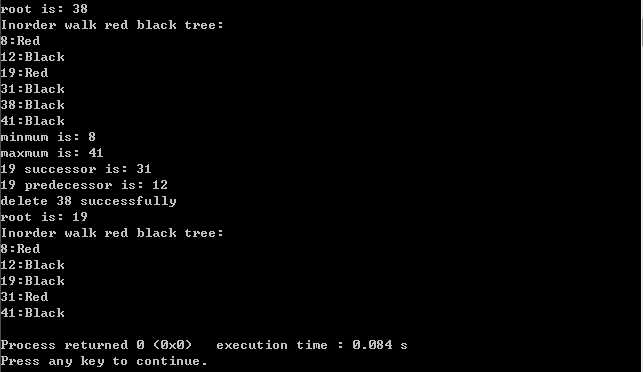
实现过程中感触非常多,需要很大的耐心去调试程序,关键的是insert和delete操作。
《算法导论》读书笔记之第14章 数据结构的扩张
前言:通常我们会遇到一些问题,采用一些标准的数据结构,如双链表、散列表或二叉查找数时,不能够满足操作要求,需要对这些数据结构进行扩张,添加一些额外的信息使得能够完成新的操作。附加的信息需要对数据结构的某些操作进行调整,这个是非常关键的步骤,决定着数据结构扩张是否能够实现。本章主要讨论了红黑树结构的扩张,介绍了两种扩张方式。第一种方式扩张使得红黑色能够支持动态集合上顺序统计,快速找出集合中第i小的数,或给出某个元素在集合的全序中的排名。第二种方式扩张使得红黑色能够进行区间操作,可以很快地找到集合中覆盖的区间。关于红黑色请参考第13章,http://www.cnblogs.com/Anker/archive/2013/01/30/2882773.html。
1、动态顺序统计
在第九章介绍了顺序统计的概念,大概的意思是在包含有n个元素的集合中,第i个顺序统计量指的是该集合中第i小的元素。在一个无序的集合中,任意顺序统计量都可以在O(n)时间内找到,详细情况可以参考http://www.cnblogs.com/Anker/archive/2013/01/25/2877311.html。书中在此基础上修改红黑树的结构,使得任意的顺序统计量都可以再O(lgn)时间内确定。向红黑树的结构中添加一个size域,表示包含自身节点的当前节点的子树节点的数目。这样修改后可以快速支持顺序统计量操作,将这种修改后的红黑树叫做:顺序统计量树T。修改后的结构如下所示:
1 struct RBTreeNode
2 {
3 int key;
4 int color;
5 struct RBTreeNode *parent;
6 struct RBTreeNode *left;
7 struct RBTreeNode *right;
8 int size;
9 };
例如给定红黑树的一个节点x,则size[x] = size[left[x]]+size[right[x]]+1。size[x]为包含以x为根的子树的节点数(包含x本身),即子树的大小。如果哨兵定义为0,即设置size[nil[T]]=0。
下面给出一个修改后的红黑树的例子,如下图所示:
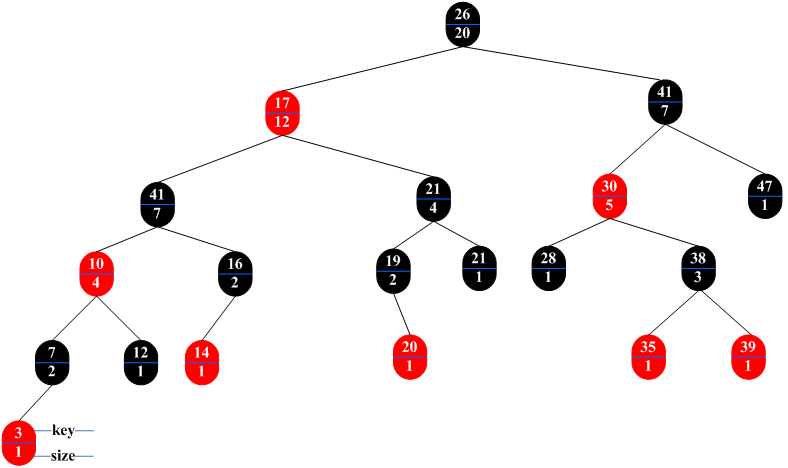
红黑树是二叉排序树,按照中序遍历从小到大输出红黑树中的关键字。从图中可以看出,添加size域后,很方便看出每个节点的子树的节点数目(包含自身节点)。书中在后面讨论这种结构的操作,分别讨论如下:
(1)检索具有给定排序的元素
过程OS_SELECT(x,i)返回一个指向以x为根的子树中包含第小关键字的结点的指针,即为了找出顺序统计量树T中的第i小关键字,可以调用OS_SELECT(root[T],i)。书中给出了伪代码如下:
1 OS_SELECT(x,i)
2 r = size[left[x]]+1; //先计算x的处于的位置
3 if i = r //x正好是第i小的关键字
4 then return x;
5 else if i < r //x比第i关键字大,则在其左子树查找
6 then return OS_SELECT(left[x],i)
7 else return OS_SELECT(right[x],i-r) //x比第i关键字小,则在其右子树查找
该过程类似二分查找,每一次递归调用都在顺序统计数中下降一层,故最坏情况下OS_SELECT的总时间与树的高度成正比,红黑树的高度为lgn。故OS_SELECT的运行时间为:O(lgn)。
(2)确定一个元素的秩(位置)
给定指向一顺序统计树T中节点x的指针,求x在顺序统计树中序遍历得到的线性序中的位置。书中给出了OS_RANK(T,x)过程的伪代码:
1 OS_RANK(T,x)
2 r = size[left[x]]+1; //获取以x为根子树中x的位置(中序遍历)
3 y = x;
4 while y != root[T] //从下向上直到根节点
5 do if y = right[p[y]] //如果是右子树
6 then r = r + size[left[p[y]]]+1;
7 y = p[y]; //向上移动
8 return r;
从程序总可以看出当y == root[T]时候循环终止,此时以y为根的子树是课完整树,此时r值是这颗整树中key[x]的秩。while循环中的每一次迭代花O(1)时间,且y在每次迭代中沿树上升一层,故在最坏情况下0S_RANK的运行时间与树的高度成正比:对含n个节点的顺序统计树时间为O(lgn)。
(3)对子树规模的维护
在红黑树中添加size域后,能够通过OS_SELECT和OS_RANK迅速计算出所需的顺序统信息。通过修改红黑树的插入和删除操作,在此过程是通过旋转来修改size域。关于这部分需要在红黑树的基础上进行改进,比较复杂,暂时没有实现。
2、如何扩张数据结构
对一种数据结构的扩张过程分为四个步骤:
1)选择基础数据结构
2)确定要在基础数据结构中添加哪些信息
3)验证可用基础数据结构上的基本修改操作来维护这些新添加的信息
4)设计新的操作
书中给出了对红黑树进行扩张的定理,并给出了证明,这个看的时候有些难度,暂时跳过了。大概意思就是说当红黑树被选作基础数据结构时,某些类型的附加信息总是可以用插入和删除来进行有效地维护。
3、区间树
这小结讲的是扩张红黑树以支持由区间构成的动态集合上的操作。区间可以很方便的表示各占用一段连续时间的一些事情。区间树是一种动态集合进行维护的红黑树,该集合中的每个元素x都包含在一个区间int[x]。区间树支持下列操作:
INTERVAL_INSERT(T,x):将包含区间域int的元素x插入到区间树T中
INTERVAL_DELETE(T,X):从区间树T中删除元素x
INTERVAL_SEARCH(T,i):返回一个指向区间树T中元素x的指针,使int[x]与i重叠,若集合中无此元素存在,则返回nil[T]。
修改红黑树得到的区间树如下图所示:
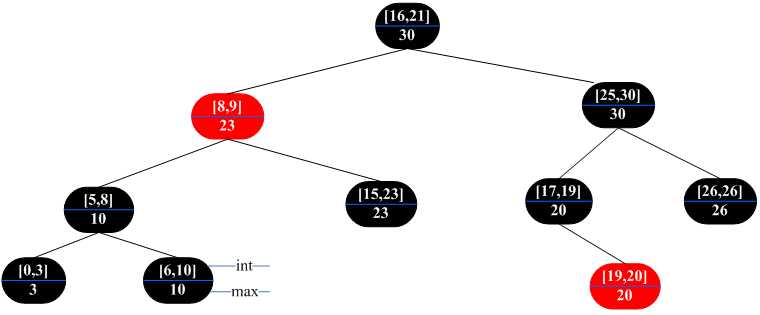
从图可以看出,对区间树以每个节点的左端点值进行中序变量即可得到有序的序列。有了区间树的结果就很容易实现其相关操作。
4、总结
本章主要是介绍一种数据结构扩张的方法,灵活性非常之大。以红黑树作为例子,我是在年前看的红黑树,并给以实现。年后了,对红黑树忘了差不多了。呵呵,真是一天不学习,赶不上啦。本章看完比较郁闷,没有去实现。实现的难度非常具有挑战性,何时能够实现,我心里有些忐忑。肯定不会放弃,一定会找个时间把这些实现一下。

